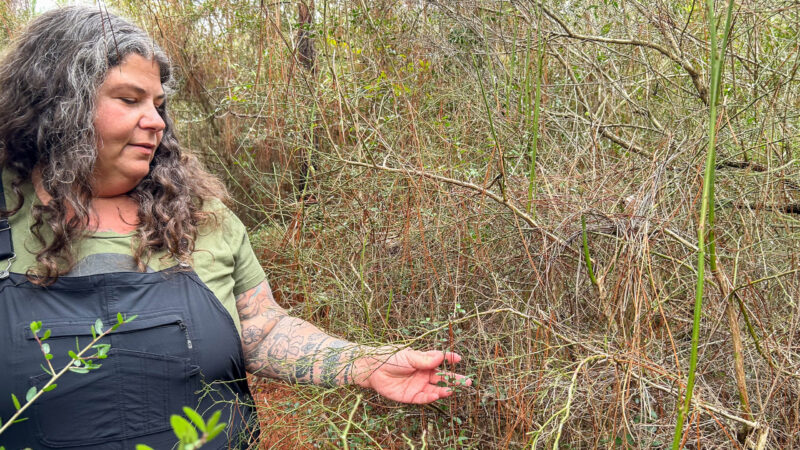Meet the Alabama woman who is turning her farm into an indigenous food forest
Angie Comeaux identifies plants growing on her farm on Friday, January 26, 2024, in Florala, Alabama. Comeaux started an indigenous food forest to reintroduce biodiversity into the local ecosystem.
Angie Comeaux walks around her farm in Florala, Alabama. She calls it Hvrvnrvcukwv Ueki-honecv, or Hummingbird Springs, Farm.
It has its own water sources – like a spring that’s not too far from her house. She and a group of volunteers planted 2,000 trees that are all native species, as well as hundreds of plant species. It’s January, so at first glance, it just looks like overgrown grass and bushes.
“A lot of folks might come out here and they’ll look around and be like 2,000 trees where? But it’s because it’s winter time and they’re still small,” Comeaux said.
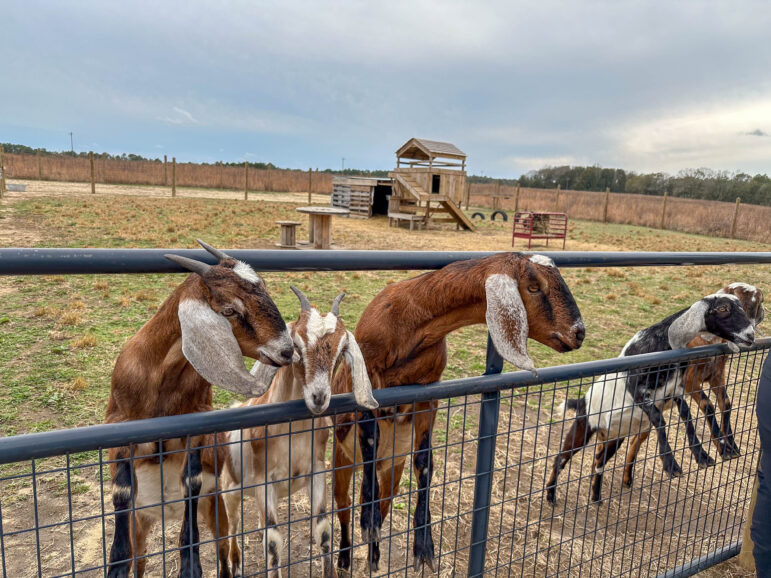
(Danny McArthur/Gulf States Newsroom)
What’s actually there is the early stages of an indigenous food forest. To understand what that is, think about corn, beans, and squash. They’re known in some circles as the Three Sisters because they grow together, like family.
“So the corn is tall, and it gives a trellis for the beans to climb up. But the beans will put nitrogen into the soil and that will help both the corn and squash grow,” Comeaux said.
The story of the Three Sisters is a smaller version of what happens in a food forest. The plants here grow stronger, together.
“The squash leaves are very prickly and they’re big and cover a lot of the ground, so it’s giving moisture control to the soil,” Comeaux said. “It also gives pest control because bugs don’t like to walk on prickly little leaves.”
From extreme heat, to periods of drought, climate change is impacting farmers in the South. In response some farmers, like Comeaux, are leaning on regenerative practices. For her, that means returning to indigenous practices that focus on preserving the land for future generations – rather than depleting it now.
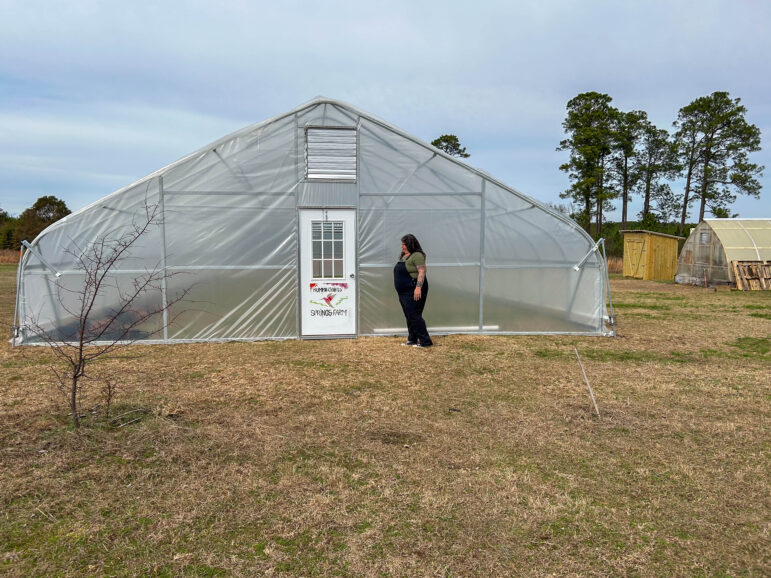
Comeaux’s journey to launching Hummingbird Springs Farm started in early 2020. She was originally born in New Orleans and raised in southeast Louisiana but she always had a goal of getting land and living off it once her children were out of the house. Then the COVID-19 pandemic hit, her son had to finish school online and she saw her chance to get started.
Comeaux, who said she’s Mvskoke, Cherokee and Chahta, came to Alabama to farm her ancestral lands. She found land from a family of multi-generational farmers looking to sell. But, when she first arrived, it was completely clear cut and hadn’t been farmed in seven years. For nearly a century before that, it had been a peanut farm. Comeaux said that kind of monoculture farming tends to leave the soil depleted.
“We definitely saw that as an opportunity to reclaim and reestablish a healthy ecosystem,” Comeaux said.
To do that, she’s using traditional ecological knowledge, or knowledge that has been passed down by generations of indigenous people based on their direct experience with the environment.
“It’s not like somebody just woke up one day and it’s like, oh, I’m going to plant these three things together. They started to observe the land and they started to observe how plant communities interacted,” said Intertribal Agriculture Council Natural Resource Specialist Nicholas Rajen. The nonprofit council works to elevate and promote Indigenous agriculture.
And there’s a larger community of indigenous agriculture and land projects happening throughout Indian Country. Rajen travels around the country learning about the different agricultural practices being used by indigenous people. They’ve seen how one tribe, the Augustine Band of Cahuilla Indians located near Coachella Valley, California, is using native plants to create hedgerows that protect the soil from wind erosion and canopies to provide shade.
They’ve also learned about prescribed burning and cultural burning that some communities use as a way to repair and heal the land.
Traditional knowledge isn’t uniform. What works in Alabama will not necessarily work in New York or California. That’s why it’s important for Comeaux to plant what naturally grows in Alabama. Planting native species is especially important in the face of climate change, which has led to Gulf South farmers experiencing more extreme heat, droughts, and colder winters than before.
“The importance there is that you actually build up a resiliency when you’re using these native species because even if they’re impacted from these strange weather occurrences or these more and more extreme weather shifts, they’re still adapted for that region and for that climate,” Rajen said.
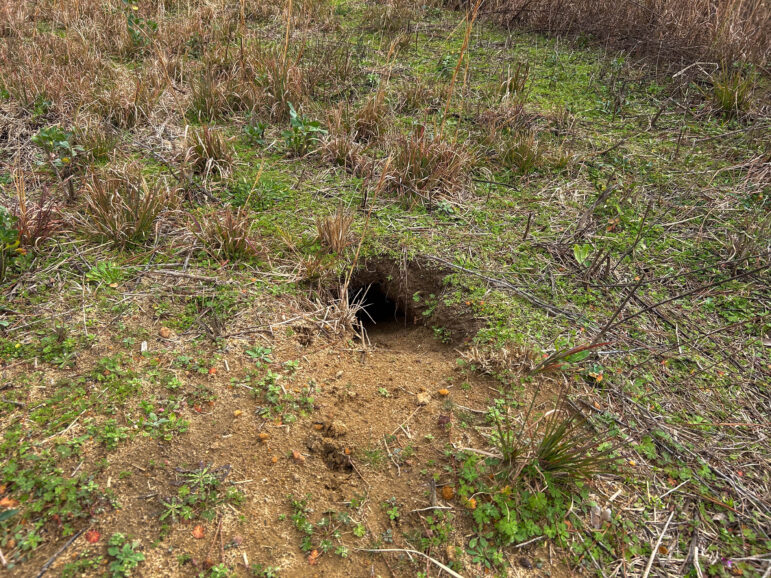
Florala, Alabama. Comeaux said that the burrows provide a home to not just gopher tortoises, but several other animals and insects who use the burrows for shelter.
(Danny McArthur/Gulf States Newsroom)
Angie Comeaux has seen this first hand. She and a group of volunteers initially planted 1400 native trees on her land. Last winter, they went back to check on them after extreme weather and she was surprised that they only lost thirty.
And she’s found another sign that what she’s doing is restoring the ecosystem here – the proliferation of gopher tortoise burrows.
Gopher tortoises are a keystone species, meaning they have a larger impact on their ecosystem than others. In two years, Comeaux said she’s seen the number of burrows grow from three to thirty.
But despite the benefits to regenerative agriculture, Comeaux says she still sees the majority of farmers practicing more extractive farming techniques – like growing one crop at a time.
“My hope is that one day farming will move towards more regenerative agricultural practices. And I think the science is showing that we have to get there. I just hope we can before it’s too late,” Comeaux said.
For now, she’s trying to create her own space where she can protect and help the local ecosystem while teaching others to do the same.
She said she isn’t farming here to make money. Her ultimate goal is to be able to provide traditional foods to her community and create a land trust so that the land she’s healing is available for future generations. In the meantime, she’s hosting workshops and sharing what she grows with her community.
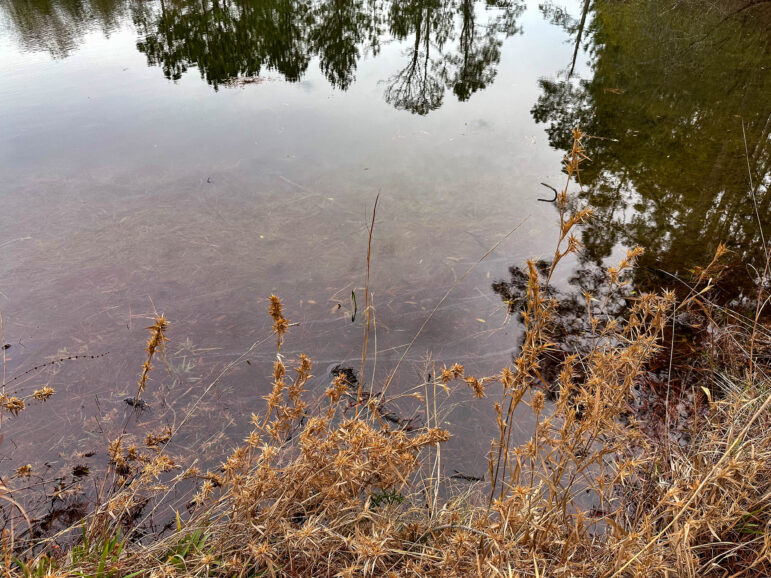
(Danny McArthur/Gulf States Newsroom)
Comeaux’s favorite spot on the farm is a frog-filled pond she uses as a water source.
“At sunset it’s so loud you can’t even hear yourself think,” Comeaux said.
When she stands here, she feels peace. All you can see and hear is the farm.
“We went from New Orleans where it’s like nonstop sirens and ambulances and power lines and just – too much – to this,” Comeaux said.
Jeffrey R. Holland, next in line to lead Church of Jesus Christ of Latter-day Saints, dies at 85
Jeffrey R. Holland led the Quorum of the Twelve Apostles, a key governing body. He was next in line to become the church's president.
Winter storm brings heavy snow and ice to busy holiday travel weekend
A powerful winter storm is impacting parts of the U.S. with major snowfall, ice, and below zero wind chills. The conditions are disrupting holiday travel and could last through next week.
Disability rights advocate Bob Kafka dead at 79
Bob Kafka was an organizer with ADAPT (American Disabled for Attendant Programs Today), a group which advocates for policy change to support people with disabilities.
‘It’s behind you!’ How Britain goes wild for pantomimes during the holidays
Pantomimes are plays based on a well-known story — often a fairy tale — which are given a bawdy twist. The audience is expected to join in throughout, shouting as loudly as they can.
Kennedy Center vows to sue musician who canceled performance over Trump name change
The Kennedy Center is planning legal action after jazz musician Chuck Redd canceled an annual holiday concert. Redd pulled out after President Trump's name appeared on the building.
Our top global photo stories from 2025: Fearless women, solo polar bear, healing soups
These stunning photos include a polar bear in a Chinese zoo, a teen in Zambia facing an uncertain future, Mongolian kids watching TV in a tent, a chef prepping a bowl of good-for-you soup.

